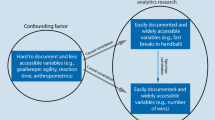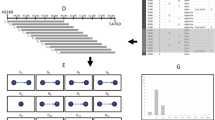Abstract
This paper discusses how social network analyses and graph theory can be implemented in team sports performance analyses to evaluate individual (micro) and collective (macro) performance data, and how to use this information for designing practice tasks. Moreover, we briefly outline possible limitations of social network studies and provide suggestions for future research. Instead of cataloguing discrete events or player actions, it has been argued that researchers need to consider the synergistic interpersonal processes emerging between teammates in competitive performance environments. Theoretical assumptions on team coordination prompted the emergence of innovative, theoretically driven methods for assessing collective team sport behaviours. Here, we contribute to this theoretical and practical debate by re-conceptualising sports teams as complex social networks. From this perspective, players are viewed as network nodes, connected through relevant information variables (e.g. a ball-passing action), sustaining complex patterns of interaction between teammates (e.g. a ball-passing network). Specialised tools and metrics related to graph theory could be applied to evaluate structural and topological properties of interpersonal interactions of teammates, complementing more traditional analysis methods. This innovative methodology moves beyond the use of common notation analysis methods, providing a richer understanding of the complexity of interpersonal interactions sustaining collective team sports performance. The proposed approach provides practical applications for coaches, performance analysts, practitioners and researchers by establishing social network analyses as a useful approach for capturing the emergent properties of interactions between players in sports teams.


Similar content being viewed by others
References
Wagner JA. Studies of individualism-collectivism: effects on cooperation in groups. Acad Manag J. 1995;38(1):152–72.
Wu B, Zhou D, Fu F, et al. Evolution of cooperation on stochastic dynamical networks. PLoS One. 2010;. doi:10.1371/journal.pone.001187.
Duarte R, Araújo D, Correia V, et al. Sport teams as superorganisms: implications of biological models for research and practice in team sports performance analysis. Sports Med. 2012;42(8):633–42.
Parrish J, Edelstein-Keshet L. Complexity, pattern, and evolutionary trade-offs in animal aggregations. Science. 1999;284(2):99–101.
Sarmento H, Marcelino R, Anguera MT, et al. Match analysis in football: a systematic review. J Sports Sci. 2014;. doi:10.1080/02640414.2014.898852.
Balague N, Torrents C, Hristovsky R, et al. Overview of complex systems in sport. J Syst Sci Complex. 2013;26(1):4–13.
Glazier PS. Game, set and match? Substantive issues and future directions in performance analysis. Sports Med. 2010;40(8):625–34.
Vilar L, Araújo D, Davids K, et al. The role of ecological dynamics in analysing performance in team sports. Sports Med. 2012;42(1):1–10.
Glazier PS. Towards a grand unified theory of sports performance. Hum Mov Sci. 2015;. doi:10.1016/j.humov.2015.08.001.
Couceiro M, Dias G, Araújo D, et al. The ARCANE project: how an ecological dynamics framework can enhance performance assessment and prediction in football. Sports Med. 2016;. doi:10.1007/s40279-016-0549-2.
Grund TU. Network structure and team performance: the case of English Premier League soccer teams. Soc Netw. 2012;34(4):682–90.
Mukherjee S. Complex network analysis in cricket: community structure, player’s role and performance index. Adv Complex Syst. 2013;. doi:10.1142/S0219525913500318.
Clemente FM, Martins FML, Couceiro MC, et al. A network approach to characterize the teammates’ interactions on football: a single match analysis. Cuadernos de Psicología del Deporte. 2014;14(3):141–8.
Wellman B, Wasserman S. Social networks. In: Kazdin A, editor. Encyclopedia of psychology. New York: American Psychological Association and Oxford University Press; 2000. p. 351–3.
Aguiar M, Gonçalves B, Botelho G, et al. Footballers’ movement behaviour during 2-,3-,4- and 5-a-side small-sided games. J Sports Sci. 2015;33(12):1259–66.
Silva P, Travassos B, Vilar L, et al. Numerical relations and skill level constrain co-adaptive behaviours of agents in sports teams. PLoS One. 2014;. doi:10.1371/journal.pone.0107112.
Kelso JAS. Synergies: atoms of brain and behaviour. Adv Exp Med Biol. 2009;629:83–91.
Kelso JAS. Multistability and metastability: understanding dynamic coordination in the brain. Philos Trans R Soc Lond B Biol Sci. 2012;367:906–18.
Salas E, Dickinson TL, Converse SA, et al. Toward an understanding of team performance and training. In: Swezey RW, Salas E, editors. Norwood. NJ: Ablex; 1992. p. 3–29.
Brannick MT, Prince A, Prince C, et al. The measurement of team processes. Hum Factors. 1995;37:641–51.
Silva P, Chung D, Carvalho T, et al. Practice effects on intra-team synergies in football teams. Hum Mov Sci. 2016;46:39–51.
Silva P, Garganta J, Araújo D, et al. Shared knowledge or shared affordances? Insights from an ecological dynamics approach to team coordination in sports. Sports Med. 2013;43:765–72.
Barabási AL, Oltvai ZN. Network biology: understanding the cell’s functional organization. Nat Rev Genet. 2004;. doi:10.1038/nrg1272.
Henttonen K. Exploring social networks on the team level: a review of the empirical literature. J Eng Technol Manag. 2010;27:74–109.
Quatman C, Chelladurai P. Social network theory and analysis: a complementary lens for inquiry. J Sport Manag. 2008;22:338–60.
Freeman LC. The development of social network analysis: a study in the sociology of science. Vancouver: Empirical Press; 2004.
Wasserman S, Galaskiewicz J. Advances in social network analysis: research from the social and behavioural sciences. Newbury Park: Sage Publications; 1994.
Rice E, Yoshioka-Maxwell A. Social network analysis as a toolkit for the science of social work. J Soc Social Work Res. 2015;. doi:10.1086/682723.
Lusher D, Robins G, Kremer P. The application of social network analysis to team sports. Meas Phys Educ Exerc Sci. 2010;14:211–24.
Gama J, Passos P, Davids K, et al. Network analysis and intra-team activity in attacking phases of professional football. Int J Perf Anal Spor. 2014;14(3):692–708.
Malta P, Travassos B. Characterization of the defense-attack transition of a soccer team. Motricidade. 2014;10(1):27–37.
Clemente FM, Couceiro MC, Martins FML, et al. Using network metrics in soccer: a macro-analysis. J Hum Kinet. 2015;45:123–34.
Yamamoto Y, Yokoyama K. Common and unique network dynamics in football games. PLoS One. 2011;6(12):1–6.
Duch J, Waitzman JS, Amaral LAN. Quantifying the performance of individual players in a team activity. PLoS One. 2010;. doi:10.1371/journal.pone.0010937.
Passos P, Davids K, Araújo D, et al. Networks as a novel tool for studying team ball sports as complex social systems. J Sci Med Sport. 2011;14(2):170–6.
Warner S, Bowers MT, Dixon MA. Team dynamics: a social network perspective. J Sport Manag. 2012;26:53–66.
Zhu J. Power systems applications of graph theory. New York: Nova Science Publishers Inc; 2011.
Bondy JA, Murty USR. Graph theory with applications. Elsevier Science Ltd: North-Holland; 1976.
Ruohonen K. Graph theory. Tampere: Tampere University of Technology; 2008.
Voloshin VI. Introduction to graph theory. New York: Nova Science Publishers Inc; 2009.
Clemente FM, Couceiro MS, Martins F, et al. Using network metrics to investigate football team players’ connections: a pilot study. Motriz. 2014;20(3):262–71.
Molm LD. Dependence and risk: transforming and structure of social exchange. Soc Psychol Q. 1994;57(3):163–76.
Sparrowe R, Liden R, Wayne S, et al. Social networks and the performance of individuals and groups. Acad Manag J. 2001;44(2):316–25.
Borgatti SP, Foster PC. The network paradigm in organizational research: a review and typology. J Manag. 2003;29(6):991–1013.
Cummings JN, Cross R. Structural properties of work groups and their consequences for performance. Soc Netw. 2003;25:197–210.
Balkundi P, Harrison D. Ties, leaders, and time in teams: strong inference about network structure’s effects on team viability and performance. Acad Manag J. 2006;49(1):49–68.
Gaston ME, DesJardins M. The effect of network structure on dynamic team formation in multi-agent systems. Comput Intell. 2008;24(2):122–57.
Fewell JH, Armbruster D, Ingraham J, et al. Basketball teams as strategic networks. PLoS One. 2012;. doi:10.1371/journal.pone.0047445.
Watts DJ, Strogatz SH. Collective dynamics of ‘small-world’ networks. Nature. 1998;393(6684):440–2.
Albert R, Barabási AL. Statistical mechanics of complex networks. Rev Mod Phys. 2002;74(1):47–97.
Passos P, Araújo D, Travassos B, et al. Interpersonal coordination tendencies induce functional synergies through co-adaptation processes in team sports. In: Davids K, Hristovski R, Araújo D, Serre N, Button C, Passos P, editors. Complex systems in sport. London: Routledge; 2014. p. 117–21.
Freeman LC. Centrality in social networks: conceptual clarification. Soc Netw. 1979;1:215–39.
Gudmundsson J, Horton M. Spatial-temporal analysis of team sports—a survey. 2016;arXiv:1602.06994v1[cs.OH].
Borgatti SP. Centrality and network flow. Soc Netw. 2005;27:55–71.
Acknowledgements
The authors would like to acknowledge João Cláudio Machado and three anonymous reviewers for the valuable insights that enhanced the quality of this manuscript.
Author information
Authors and Affiliations
Corresponding author
Ethics declarations
Funding
No financial support was received for the planning or conduct of the research presented in this article.
Conflict of interest
João Ribeiro, Pedro Silva, Ricardo Duarte, Keith Davids and Júlio Garganta declare that they have no conflicts of interest relevant to the content of this article.
Rights and permissions
About this article
Cite this article
Ribeiro, J., Silva, P., Duarte, R. et al. Team Sports Performance Analysed Through the Lens of Social Network Theory: Implications for Research and Practice. Sports Med 47, 1689–1696 (2017). https://doi.org/10.1007/s40279-017-0695-1
Published:
Issue Date:
DOI: https://doi.org/10.1007/s40279-017-0695-1




